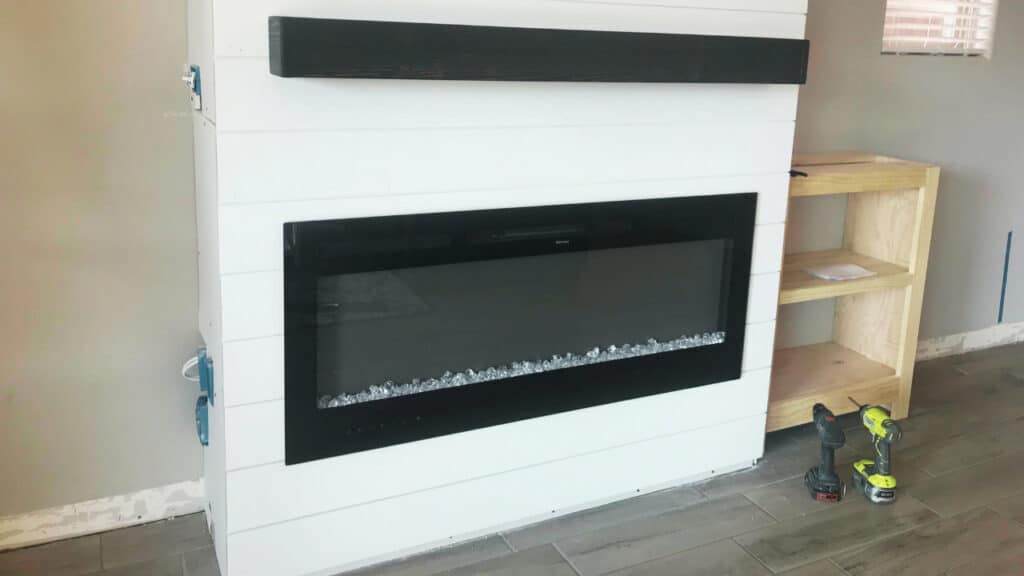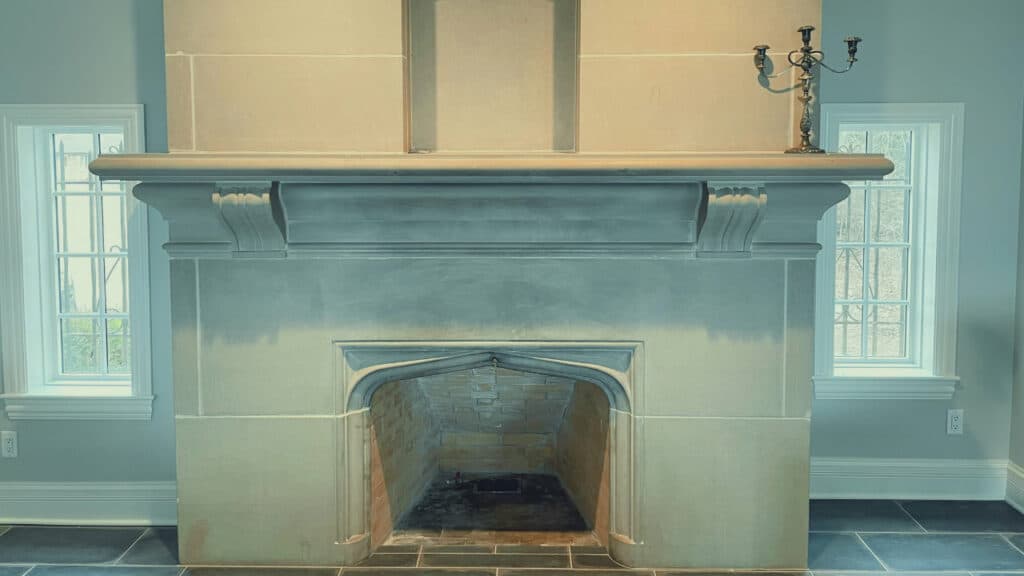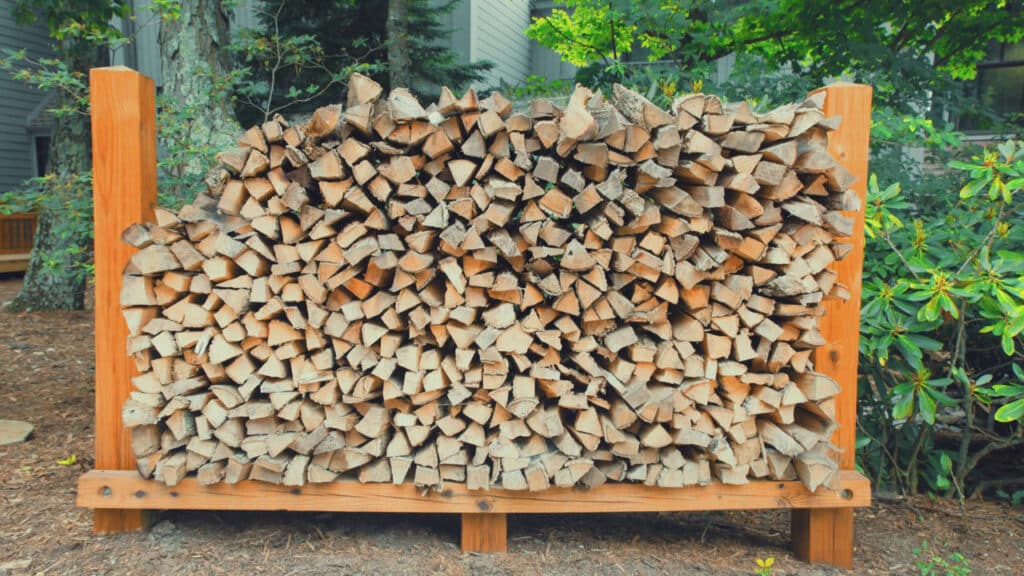The importance of learning how to stack firewood properly cannot be overstated. Although it can seem like a fairly straightforward job, there is an art to it that is as much about practicality as it is about ensuring longevity and burning efficiency.

There is no point in choosing between kiln-dried and seasoned firewood if you have a poor stacking technique. By mastering the right methods, you can remove moisture, dry your firewood much more efficiently, and enjoy burning it in your fireplace.
In this post, we’ll explore the essential techniques for stacking firewood and the different methods of doing it, ensuring that it’s dry and accessible. Additionally, we’ll provide wood stacking safety tips and the common mistakes to avoid.
Let’s begin this journey by mastering the essential task of stacking wood.
How To Stack Firewood in Your Home
Here are the basic steps you should follow to achieve an effective firewood stack.
Step 1: Location, Location, Location
You can’t store firewood fuel just anywhere in your backyard. Pick a dry, elevated area around your lot. Ideally, the spot should get plenty of sun and wind, which will help the wood dry. It’s also a good idea to find a shelter for your wood away from buildings to avoid pest invasions.
Step 2: Create a Base

A base for your wood firestack will prevent moisture from seeping up from the ground and promote circulation beneath the stack. You can use pallet boards, gravel, or concrete blocks as a base.
Step 3: Get Good Air Circulation
You want to stack your wood so air can flow freely around each piece. This is essential for drying the wood out and preventing mold or mildew. You also want to leave enough space around your woodpile to easily inspect and remove debris. Regularly doing so will help maintain the quality of your firewood.
To protect your stack from rain or snow, use a tarp or plastic sheeting. However, keep the sides open to allow for airflow.
Step 4: Keep it stable
Build your stack so it’s stable and won’t easily topple over. Place the wood in rows, with each piece touching the next, and use a crisscross pattern at the ends for added stability. It’s also good practice to keep your woodpile no longer than 4 feet to ensure safety, stability, and accessibility.
Step 5: Store different types separately
If you have varying types of wood, consider stacking them separately. Different types of wood dry at different rates. Sort your stack so that you can access the oldest wood first. You want to get to your most seasoned wood first before moving on to the new ones.
Now that you know the basic principles of stacking firewood, let’s explore the different tricks for stacking your firewood.
Tools and Equipment Needed
Stacking firewood safely requires a few basic tools and materials. These will make the task easier and faster and ensure your woodpile is stable and protected.
- Gloves for protecting your hands from splinters and dirt.
- Base materials such as pallets, gravel, or concrete blocks can raise the base of your woodpile.
- Measuring tape for planning where you intend to stack the wood and maintaining uniform rows.
- Waterproof tarps or woodpile covers to protect the top of your stack from the weather.
- Saw or chainsaw for cutting firewood that’s not precut to your desired length.
- Wheelbarrow or cart for transporting logs from the cutting area to the delivery spot.
Optional tools:
- Mallet and stakes if you’re planning to build a freestanding woodpile.
- Log rack as storage for small quantities of wood that you want to keep off the ground.
- Log splitter for processing firewood from larger logs.
- Twine or rope cords are used to secure the ends of the stack or keep the tarp in place.
Firewood Stacking Methods
Here are the best firewood stacking methods to maximize efficiency and ensure your wood burns cleanly and effectively:
1. The Crisscross Method
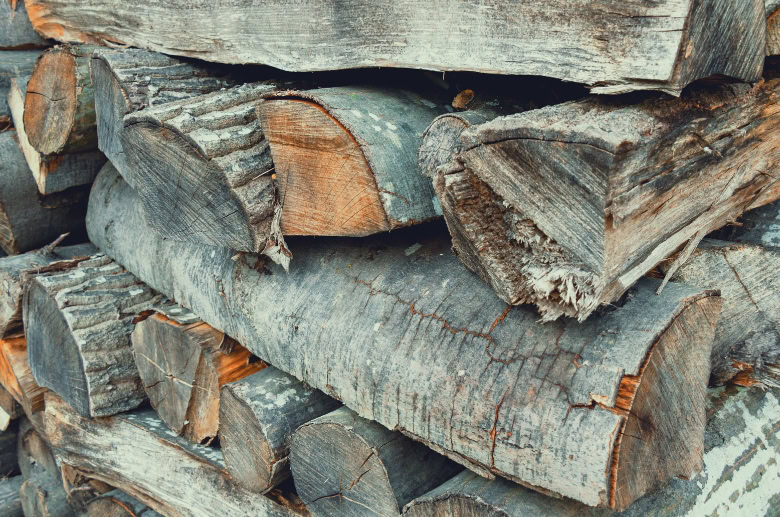
The crisscross stacking technique involves arranging firewood or similar materials in alternating layers at right angles to each other. This method is the easiest to build and promotes excellent airflow. It also provides structural stability to the woodpile.
How to do it:
- Start with a base layer and then lay two pieces of firewood parallel to each other at the bottom.
- Then, lay two pieces perpendicularly on top of the first two near the ends.
- Continue stacking the wood in alternating layers, with each layer perpendicular to the one below it.
- The result should be a crisscross pattern that looks like the walls of a log cabin.
2. German Stacking Method
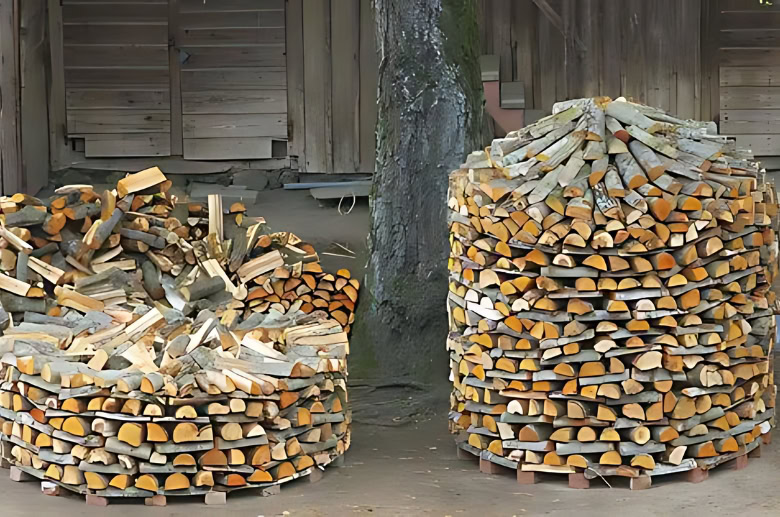
The German stacking method, also known as “Holz Hausen,” which translates to “wood house,” is a traditional European method of stacking and seasoning firewood. It’s perfect for seasoning wood because it’s organized in a circular dome-like structure that promotes air circulation. The exterior of the stack looks like a beehive, which is why this method is also known as the “beehive method.”
How to do it:
- Start with a base and then lay out small logs in a circle on the ground. Aim for a diameter of about 6 to 8 feet.
- Begin stacking the firewood around the perimeter of the circle, placing the logs as close together as possible.
- As you build, slightly tilt the logs inward to create a distinctive dome shape. The inward tilt helps the structure support itself and shed rainwater off the pile.
- Continue stacking wood in layers, maintaining the inward tilt. The walls will gradually curve in to form the dome.
- Once it reaches your desired height (around 4 to 5 feet), top with a layer of wood placed more horizontally to cover the structure. You may also cover the tarp with a tarp secured with ropes to protect against rain.
3. Round Stack Method/Norwegian Stacking Method
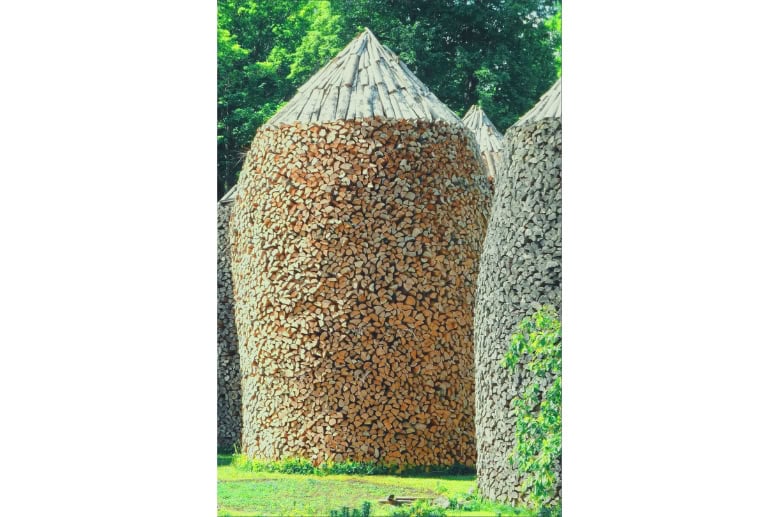
The round stack method is another efficient and neat way to stack firewood. It originated in Norway and is known for its circular design, which promotes air circulation for faster drying and minimizes the woodpile’s footprint. It involves creating a circular stack of wood, and as the stack grows, the wood is arranged to tilt slightly inwards, creating a self-supporting dome or beehive shape.
How to do it:
- Create a circular base and then start stacking logs vertically around the perimeter of the circle.
- Logs are placed standing up, leaning slightly inward as the circle builds up. This inward lean is important for stability and helps the stack support itself as it grows taller.
- Leave the middle of the circle empty initially. As the stack grows in height, you will fill the center later with smaller pieces of wood or kindling.
- Once you have achieved the desired height (no more than 4 feet), top it off with a layer of logs placed horizontally. This will cover and protect the stack from direct rain while still allowing air to circulate through the sides and the top.
4. Straight Row Method/American Stacking Method
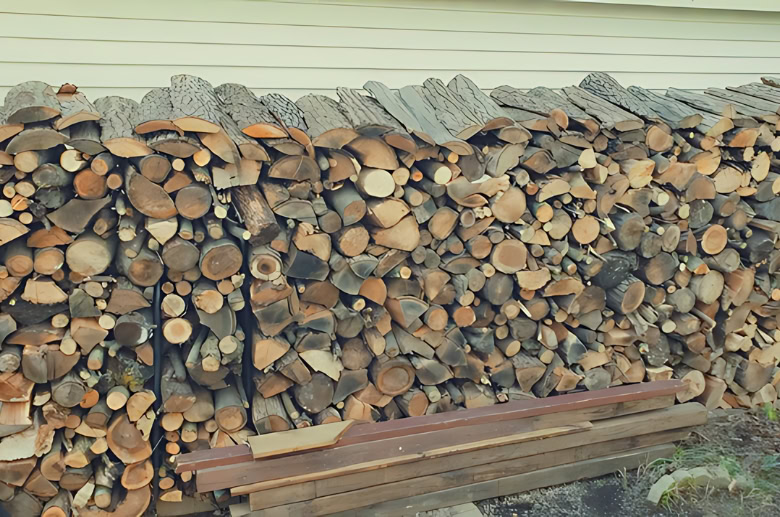
The straight-row method is a widely used approach for stacking firewood because it’s simple, efficient, and effective. Each layer of logs is stacked directly on top of the one below it, often with small gaps between the logs for airflow. It’s simple and effective because it can be done on any flat area and allows for easy covering with tarps.
How to do it:
- Start with a level base for stacking the firewood. Then, build supports using a crisscross pattern of logs. These are the start and end of your rows, which act as bookends to hold the row of logs in place. Alternatively, you can use existing structures such as walls or sturdy posts as the end points of your rows.
- Place the logs side by side in a single row, keeping the stack as even as possible. The wood should lie flat against one another to maximize contact between logs, reducing gaps and improving stability.
- As you stack, make sure to leave small spaces between the logs to allow air to circulate.
5. Alternating Split Sizes
The alternate split sizes method improves the drying process and stability of the firewood stack. It involves alternating the direction of the split pieces of wood within each layer or alternating between different sizes of split wood. This method requires a bit more planning and effort, but it has great benefits for drying and stability, especially in humid climates.
How to do it:
- Begin with your base layer to keep wood off the ground. Start your stack with a layer of wood placed parallel to each other. This layer can consist of larger or more uniformly sized pieces to create a stackable base.
- For each new layer, alternate the orientation or size of the wood pieces.
- To help the structure maintain its integrity, use larger, more durable pieces at the stack’s ends or build criss-cross end supports.
- The goal of alternating sizes is to create a more interlocked stack, reducing the chances of the stack falling.
As you stack wood, you learn the best ways through trial and error. Each piece of wood, with its unique shape and size, requires you to adapt and find the most efficient way to stack it securely. The more experience you have, the more confident you will be in your wood stacking skills.
Common Stacking Mistakes to Avoid
People make several mistakes when stacking forest firewood, which can lead to issues like mold growth, pest infestation, wood rot, or unstable stacks. These are the most common mistakes you should avoid and their solutions.
Mistake #1: Stacking on the Ground
Do not place firewood directly on the ground or grass without a barrier, as this can lead to moisture absorption from the soil. It can lead to wood rot and make the firewood hard to burn. Always have a raised foundation where you can stack your wood.
Mistake #2: Overcrowding the Wood Pile
Stacking wood too tightly or against the wall edge without leaving space for air can hinder the drying process. Make sure there’s enough room between the wood stacks and between the wood and any barriers to allow for good airflow.
Mistake #3: Covering the Stack Completely
It can seem like a good idea since it protects firewood from weather exposure, but you don’t want to do this. Completely covering the stack can trap moisture and reduce air circulation, leading to mold and mildew. Only cover the top and leave the sides open for airflow.
Mistake #4: Ignoring Orientation
The direction in which you stack the wood can affect drying times. To speed up the drying process, you want to maximize its exposure to the sun and prevailing winds. If the stack is in a shaded area, oriented away from the sun’s path, or restricts airflow, it will dry more slowly.
Mistake #5: Stacking too high
A tall stack might save you yard space, but it can get unstable and dangerous. Keep stacks at a manageable height, no more than 4 feet, to maintain stability.
Mistake #6: Not Planning for Drainage
If the area where the stack is prone to puddling or flooding, moisture can seep into the wood’s bottom layers, leading to damage. To avoid this, make sure that the stacking site has good drainage.
What is The Best Firewood to Burn in a Fireplace?
The best firewood to burn is typically seasoned hardwood because of its density and high energy content. Hardwood burns hotter and longer than softwood. Hardwood products also produce less creosote, which can accumulate in your chimney and pose a fire hazard.
Hardwood options include oak, maple, birch, ash, beech, hickory, and cherry. When making a choice, pick well-seasoned wood, which burns slower and produces less creosote. The best firewood is one that you can order from your local forestry producer, as it is cheaper and has a low environmental impact.
Wood Stacking Safety Tips for Homeowners
Improperly stacked wood can pose various risks, including the potential for injury from falling logs, pest infestations, and fire hazards. Here are some safety stacking tips to keep in mind.
- Keep a distance from structures. Your woodpile should be at least 20 to 30 feet away from the exterior of your house or any other structures to reduce the risk of fire spreading and discourage pests, termites, and insects from moving into your home.
- If the wood stack is high, consider using stakes or supports at the ends to prevent the logs from rolling off. You can also build or buy a firewood rack for better stability.
- Do not stack wood near fire pits, grills, or areas on your property where open flames are used. Sparks or embers can easily ignite a woodpile.
- Regular maintenance of your stack is essential. Ignoring your wood stack for long periods could mean you miss warning signs of diseases, decay, pests, or instability. If necessary, restack some sections to maintain safety and airflow.
- If you have children or pets, teach them not to touch and stay away from the woodpile to avoid accidents. If necessary, consider fencing off the area.
Conclusion
You have just learned everything there is to know about stacking firewood, from the basic principles and methods of stacking to the best types of wood to burn in the fireplace.
By adopting this age-old practice, you’re not only ensuring that your firewood burns efficiently and safely; you’re also inviting a piece of nature’s raw beauty into your daily life.
Frequently Asked Questions
Here are the most common questions about firewood stacking.
How Long Should Firewood Dry Before Burning?
Firewood’s drying time, also referred to as seasoning, typically ranges from 6 to 24 months. Hardwoods like oak, maple, and beech generally take longer to season than softwoods such as pine, fir, and cedar.
Each type of wood has unique characteristics and drying times. Mixing different types of wood can help achieve a balance between ease of ignition, heat output, and burn duration.
Should I Stack the Bark Up or Down?
It depends. Stacking the bark up can protect against moisture from rain or snow since the bark’s natural structure can repel water. Bark-up can also help with the drying process by protecting the wood from direct moisture.
Stacking wood with the bark down can provide better stability and help with airflow around the wood, especially if moisture from the ground is a concern.
Can You Stack Wet Firewood?
Yes, stacking wet firewood can work, but it’s important to do it in a manner that promotes drying to prevent the development of mold or fungus.
You want to stack it somewhere that gets plenty of sunlight and has good circulation. The sun and wind can help evaporate moisture from the wood and help it dry faster. This is important, as otherwise, firewood won’t burn as efficiently and will produce more creosote than usual.



